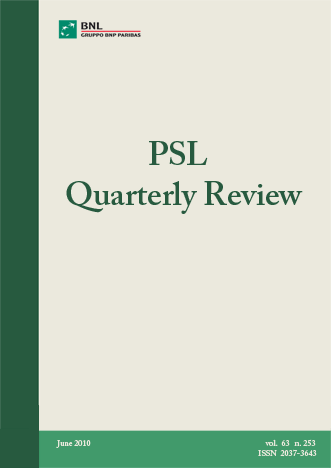Monetary policy and world commodity markets: 2000-2007
DOI:
https://doi.org/10.13133/2037-3643/9433Keywords:
Monetary Policy, Asset Inflation, Commodity PricesAbstract
Expansionary monetary policy in key industrial countries and a rapidly depreciating US dollar sent commodity prices soaring at unprecedented rates during 2003–2007. In contrast, consumer price indices in major OECD countries, a leading indicator for monetary policy, showed almost no inflation. This twin development is a puzzle as the evolution of consumer prices were not responsive to record low interest rates, doubledigit commodity inflation, and a sharp depreciation of the dollar. A common trend, identified as a monetary shock, drives commodity prices. Policymakers face a policy dilemma: maintain expansionary monetary policy stance with persistent commodity price inflation, subsequent severe world recession, and financial disorder, or tighten monetary policy with subsequent sustained economic growth and financial and price stability.
JEL Codes: C10, C22, E31, E52, Q40
References
BATIEN D. (1981), “Inflation: the cost-push myth,” Federal Reserve Bank of St. Louis, June/July.
BEVERIDGE S. AND NELSON C. R. (1981), “A new approach to decomposition of economic time series into permanent and transitory components with particular attention to measurement of the business cycle,” Journal of Monetary Economics, vol. 7, pp. 151-174.
BLANCHARD O. J. AND GAIL J. (2008), “The macroeconomic effects of oil price shocks: why are the 2000s so different from the 1970s?,” MIT Department of Economics, Working Paper, n. 07-21.
CECCHETTI S., BENBERG G., LIPSKY J., AND WADHWANI S. (2000), “Asset prices and central bank policy,” The Geneva Reports on the World Economy, n. 2.
CHRISTIANO L.J. AND FITZGERALD T. (2000), “Understanding the fiscal theory of the price level,” Federal Reserve Bank of Cleveland Economic Review, vol. 36, pp. 1-37.
ENGLE R.F. AND GRANGER C.W.J. (1987), “Co-integration and error correction: representation, estimation and testing,” Econometrica, vol. 55, pp. 251-256.
FRANKEL J. (2008), “The effects of monetary policy on real commodity prices,” in Campbell, J. (ed.), Asset Prices and Monetary Policy, University of Chicago Press, Chicago, pp. 291-327.
FRIEDMAN M. (1972), An Economist’s Protest, Thomas Horton and Company, New Jersey.
FRIEDMAN M. (1969), The Optimum Quantity of Money and Other Essays, Aldine Publishing Company, Chicago.
FRIEDMAN M. (1959), A Program for Monetary Stability, Fordham University Press, New York.
GONZALO J. AND GRANGER C. (1995), “Estimation of common long-memory components in co-integrated systems,” Journal of Business and Economic Statistics, vol. 13, n. 1, pp. 27-35.
HUMPHREY T.M. (1982), Essays on Inflation (Third Edition), Federal Reserve Bank of Richmond.
KEYNES J.M. (1936), The General Theory of Employment, Interest, and Money, A Harvest/HBJ Book, First Harbinger Edition, 1964.
KINDLEBERGER C.P. (2009), “Asset inflation and monetary policy,” PSL Quarterly Review, vol. 62, nn. 248-251, pp. 29-50.
KING R., PLOSSER C., STOCK J., AND WATSON M. (1991), “Stochastic trends and economic fluctuations,” American Economic Review, vol. 81, pp. 819-840.
RONCAGLIA A. (2003), “Energy and market power: an alternative approach to the economics of oil,”, Journal of Post Keynesian Economics, vol. 25, n. 4, pp. 541-659.
WARNE A. (1993), “A common trends model: identification, estimation and inference, seminar paper,” Working Paper n. 555, Institute for International Economic Studies, University of Stockholm.
Downloads
Published
How to Cite
Issue
Section
License



